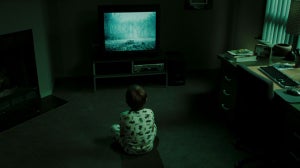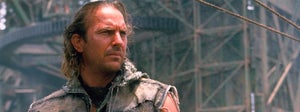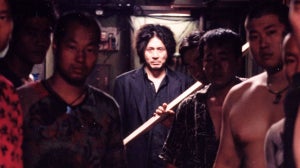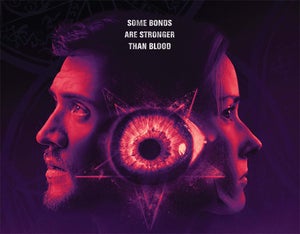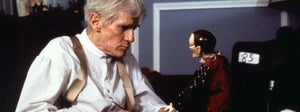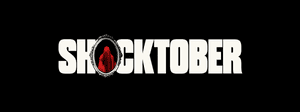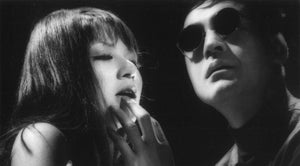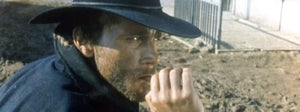
There are more killers behind the masks than the usual iconic forays into horror. As far back as Lon Chaney’s rendition of the eponymous character in Universal’s The Phantom of the Opera, the template was set; the genre embracing many iconic disguises from the innocent Christiane in Eyes Without a Face, to the slew of slasher villains that would follow almost two decades later. Forget the nightmares, boiler suits, and unlucky Fridays; this Halloween why not check out some of the other (more unusual) masks that cinematic psychos have worn over the years…
Blood and Black Lace (1964)
In what is one of the most definitive Italian Giallo movies, Mario Bava set the template for what was required for the subgenre. Not only does Blood and Black Lace boast lush cinematography but also a mysterious villain whose blank features would go on to inspire DC comics’ The Question and, in turn, Alan Moore’s Watchmen vigilante Rorschach. Influential threads of sack-headed protagonists can also be seen in the shape of protagonist Jonathan Preest in Franklyn and Cronenberg’s performance as the deranged psychotherapist Dr. Decker in Clive Barker’s Nightbreed. What Bava cleverly develops here (through his mask) is the use of deception in which men take on feminine roles and women take on masculine roles; a sleight of hand that can be felt the following decade in the likes of John Carpenter’s Halloween.
https://www.youtube.com/watch?v=WCb-GiEj5xw
Onibaba (1964)
The Japanese say you have three faces. The first face, you show to the world. The second face, you show to your close friends and family. The third face, you never show anyone… and that it is the truest reflection of who you are. Set during the violent outbreak of a civil war, Kaneto Shindo’s film tells the story of lust and jealousy, in which a mother and her daughter-in-law hope for the safe return of their son/husband. When the wife begins an affair, the jealous mother-in-law wears the Hannya mask of a disfigured samurai she has murdered and soon finds out that once the mask is drenched, it remains fixed. Now cursed as much as the man she took it from, once it is removed, it tears flesh, her rotten face now a true reflection of her jealous heart and corruptive nature.
https://www.youtube.com/watch?v=vCPEJ982dxo&pp=ygUPb25pYmFiYSB0cmFpbGVy
The Abominable Dr. Phibes (1971)
Over the years there have been many horror movies inspired by Gaston Leroux’s 1909 novel, The Phantom of the Opera. Not just the subsequent Universal adaptations — Chaney’s in 1925 and Claude Raines in 1943 — but also the camp re-imaginings and goofball pastiches that include Brian De Palma’s Phantom of the Paradise and Richard Friedman’s Phantom of the Mall: Eric’s Revenge. Robert Fuest’s first Dr. Phibes film for Roger Corman’s American International Pictures is, of course, another campy affair with Vincent Price on top form engineering his “instruments of death”. The irony here, of course, is that his familiar face is the very mask he wears. If anything, the film is the perfect companion piece to Sam Raimi’s own Phantom tribute, Darkman, from 1990.
https://www.youtube.com/watch?v=sxnr9xycVLo
Stage Fright(1987)
Michele Soavi’s feature debut is a smart Italian slasher that employs the ruse of a killer amongst a theatrical production which, for the most part, plays into what is ‘staged’ and what becomes the ‘act’ of a deranged killer. When mental patient (and former actor) Irving Wallace hides behind the elaborate mask of the fictional killer the Night Owl, a bloodbath follows on stage and behind the scenes. The theatrical context lends more weight and texture to the proceedings, Soavi’s inventiveness setting him apart from his protégé Dario Argento, especially by the time he reaches the heights of 1994’s Dellamorte Dellamore, aka Cemetery Man.
https://www.youtube.com/watch?v=hs7PHsWzvwE
Edge of the Axe (1988)
Similar to Spanish-American production Pieces, José Ramón Larraz’s film was aimed predominantly at the U.S. market. Falling by the wayside during a time when the slasher boom had all but dried up, Edge of the Axe had bad timing but makes up for it with attitude. It may be lacking Bava’s artistry but it shares some similarities to Blood and Black Lace with a deceptive element one would expect from the genre; the featureless killer’s mask resembling a more masculine version of Christiane’s porcelain visage in Eyes Without a Face that, once again, helps play as a red herring when the killer’s duality is finally revealed.
https://www.youtube.com/watch?v=wgz4kT8_KNc
Behind the Mask: The Rise of Leslie Vernon (2006)
There are more humorous shades of Man Bites Dog and The Last Horror Movie in this horror mockumentary as a journalist and her camera crew are lured in by the charismatic creep, Leslie Vernon. While Scott Glosserman’s film sets out to deconstruct the genre we are so familiar with — the meta approach enhanced by various cameos from the likes of Robert Englund and Kane Hodder — it eventually drops the gimmick and leans heavily into the cinematic. Vernon’s mask — partly inspired by his theatricals — resembles a deathly inner child that highlights as much about his stunted development as it does his playful sense of humour.
https://www.youtube.com/watch?v=7RiJDEZywlw
Cub (2014)
In this overlooked Belgian horror from director Jonas Govaerts, we are thrust into a territory reminiscent of William Golding’s Lord of the Flies. As camp side tales spark the imagination of our protagonist Sam, his fellow cub scouts — who ridicule and bully him — soon find themselves hunted. When Sam then befriends a feral kid, it soon becomes apparent that this ‘cub’ is all part of the hunt as the rest of the scouts are slowly picked off by a larger threat; a nameless poacher who has armed the forest with various traps. Named after the werewolf myth the scouts have spooked each other with, the untamed ‘Kai’ wears a pagan-like mask; its asymmetrical design of which hints at the God Pan or the demonic vibes we have grown so accustomed to under Catholic rule.
https://www.youtube.com/watch?v=KKVo-MP2Ajc
I See You (2019)
The less you know about Adam Randall’s film, the better. Suffice it to say (without giving too much away), the masked killer at the centre of I See You ends up as one of the most sympathetic. His frog-like mask is perfectly designed for lurking in the shadows… and there is a stillness at play that fits with Alec’s motivations, all of which is integral to the final twist. Much more than a horror movie, there is something deeply unsettling at the centre of the plot as it literally hops from one genre to the next. This isn’t quite the ‘bullet proof’ idea of masks associated with vigilantes, but, by the end of the film, perfectly aligns with Agatha Christie’s notion that, “The human face is, after all, nothing more nor less than a mask.”
https://www.youtube.com/watch?v=yjMdPvurOJM

Related Articles
